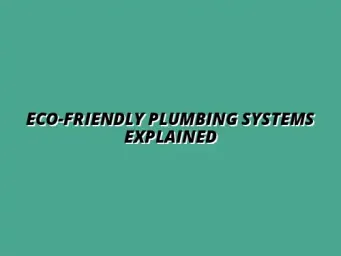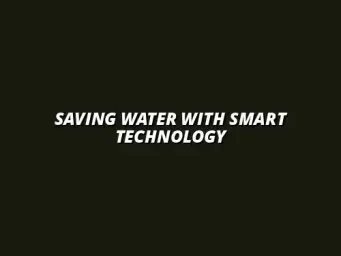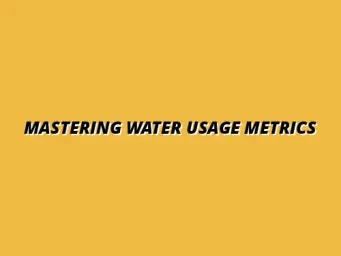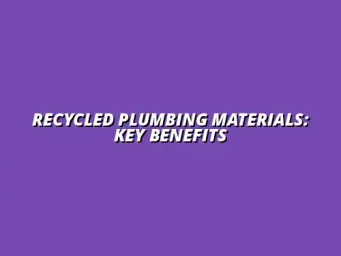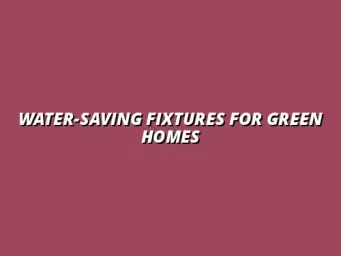Understanding the Impact of Plumbing Waste on the Environment
Plumbing waste plays a crucial role in environmental health, affecting not only water quality but also overall ecosystem balance. It's essential to understand what constitutes plumbing waste and where it comes from. By identifying its sources, we can better appreciate its impact and how to mitigate it for a healthier planet.
In essence, plumbing waste includes all the waste materials generated from our plumbing systems. This can originate from residential, commercial, and industrial sectors. Common sources include leaky pipes, wastewater from appliances, and even debris from plumbing repairs. Regular water heater maintenance can also help reduce waste.
Defining Plumbing Waste and Its Sources
To grasp the environmental implications, we should define plumbing waste clearly. This waste can be any unwanted material that comes from plumbing operations and systems. Understanding its various sources is vital for developing effective waste management strategies.
Common sources of plumbing waste include:
- Household waste: This includes wastewater from sinks, toilets, and appliances.
- Construction debris: Waste generated during plumbing installations or repairs.
- Industrial waste: Discharged water and chemicals from factories that utilize plumbing systems.
Common Types of Plumbing Waste Generated
Plumbing waste can be categorized into several types, each posing different challenges for disposal and treatment. Understanding these categories can help us find better solutions to manage them effectively.
- Liquid waste: This includes graywater from sinks and showers, as well as blackwater from toilets.
- Solid waste: Material such as grease, hair, and food particles that can clog pipes.
- Chemical waste: Substances like solvents, cleaners, and pharmaceuticals that are harmful to the environment.
Environmental Consequences of Excess Plumbing Waste
The overproduction of plumbing waste can lead to severe environmental issues, including water pollution and habitat destruction. When plumbing waste is not adequately managed, it often ends up in rivers, lakes, and oceans, creating detrimental effects on aquatic life. Implementing effective water conservation at home is a crucial step in reducing this waste.
Some consequences of excess plumbing waste include:
- Water contamination: Harmful chemicals can seep into water sources, affecting both wildlife and human health.
- Soil degradation: Improper disposal can lead to polluted soils, affecting plant growth and ecosystem health.
- Increased treatment costs: Communities face higher expenses for cleaning contaminated water sources.
The Role of Sustainable Materials in Plumbing
As we look for solutions to reduce plumbing waste, sustainable materials emerge as a critical component. Utilizing eco-friendly options not only helps minimize waste but also promotes a healthier environment. Understanding these sustainable materials can empower homeowners and professionals alike to make better choices. A comprehensive guide to eco-friendly plumbing materials can help you make informed decisions.
With a focus on sustainability, we can create plumbing systems that are less harmful to the environment. By choosing materials that are recyclable, durable, and manufactured responsibly, we can significantly cut down on our plumbing waste footprint.
Addressing Frequently Asked Questions About Sustainable Plumbing
Curiosity about sustainable plumbing is growing, and many people want to know more about the best choices for their homes. Understanding the options can lead to significant benefits, both for the environment and for your wallet. Let's dive into some common questions to clarify the landscape of sustainable plumbing.
What Types of Sustainable Materials Are Best for Plumbing?
When it comes to plumbing, various sustainable materials stand out for their eco-friendliness and efficiency. Evaluating these materials can help you make informed decisions about your plumbing system. Here’s a look at some popular eco-friendly plumbing materials:
- Copper: Highly durable and recyclable, copper is resistant to corrosion.
- PEX (Cross-Linked Polyethylene): This flexible material has a lower carbon footprint and is easier to install.
- Recycled PVC: An excellent alternative for drainage systems, recycled PVC reduces plastic waste.
- Cast Iron: Known for its durability, cast iron can last for decades and is recyclable.
Evaluating Popular Eco-Friendly Plumbing Materials
Choosing the right sustainable material involves considering factors like longevity, maintenance, and environmental impact. For kitchen plumbing, consider the durability of materials for kitchen pipes. Eco-friendly materials often boast several characteristics that make them suitable for plumbing. You should evaluate:
- Resistance to corrosion and wear.
- Recyclability at the end of their life cycle.
- Energy efficiency during production and installation.
By understanding these factors, homeowners can select materials that not only meet their plumbing needs but also support sustainable practices.
How Can Homeowners Assess Their Plumbing Waste Footprint?
Assessing your plumbing waste footprint is essential for identifying areas for improvement. It can guide you toward making more sustainable choices. Here’s how you can evaluate the waste generated by your plumbing:
- Conduct a Water Usage Audit: Track your water consumption through bills and meter readings.
- Inspect Fixtures: Check for leaks and inefficient fixtures that waste water. Learn more tips on conserving water in your bathroom with this helpful guide: Conserve water in your bathroom.
- Evaluate Appliance Efficiency: Assess the energy and water efficiency ratings of your appliances.
Practical Steps for Assessing Plumbing Waste Generation
After evaluating your plumbing waste, consider practical steps to reduce it. Start by implementing small changes that can make a big impact:
- Replace old fixtures with water-saving options.
- Consider installing a rainwater harvesting system.
- Monitor your water usage regularly to identify trends and areas for improvement.
By following these steps, homeowners can better understand and reduce their plumbing waste footprint, leading to a more sustainable lifestyle.
Future Trends in Sustainable Plumbing Practices
The future of plumbing is not only about materials but also involves innovative practices and shifts toward sustainability. As technology evolves, so do our options for reducing plumbing waste. Let’s explore some exciting trends on the horizon! Learn how to create eco-friendly plumbing for green homes for a sustainable future.
Innovations in Plumbing Technology for Waste Reduction
New technologies are emerging that aim to minimize waste and enhance efficiency in plumbing systems. These innovations are making sustainable plumbing practices more accessible. Some noteworthy advancements include:
- Smart Water Meters: Enable real-time monitoring of water usage.
- Leak Detection Sensors: Alert homeowners to potential leaks before they become costly issues.
- Greywater Recycling Systems: Allow the reuse of wastewater for irrigation and non-potable purposes. Discover more about the benefits of greywater systems and water conservation.
Emerging Sustainable Materials and Technologies
As sustainable plumbing continues to gain traction, new materials and technologies are being developed. Some exciting options include:
- Biodegradable Pipes: Made from natural materials, these pipes break down at the end of their life cycle.
- Solar-Powered Water Heaters: Utilizes renewable energy to heat water efficiently.
- 3D-Printed Plumbing Components: Reduces material waste and allows for custom designs.
Embracing these innovations can significantly reduce plumbing waste and promote a greener future.
The Shift Towards Circular Economy in Plumbing
Another important trend is the shift towards a circular economy in plumbing, where resources are reused and recycled rather than disposed of. This approach minimizes waste and maximizes the lifecycle of materials. Key principles include:
- Design for Disassembly: Products are designed to be easily taken apart for repair or recycling.
- Resource Recovery: Systems that recover and reuse materials from existing plumbing.
- Lifecycle Assessment: Evaluating the environmental impact of materials throughout their entire lifecycle.
Key Principles of Circular Plumbing Practices
Implementing circular plumbing practices involves various strategies to reduce waste. Homeowners can consider:
- Participating in recycling programs for old plumbing materials.
- Choosing plumbing products from manufacturers that prioritize sustainability.
- Educating themselves and others about the importance of a circular economy.
By adopting these principles, we can contribute to a more sustainable and waste-free plumbing industry.
Encouraging Sustainable Practices in Your Community
Becoming an advocate for sustainable plumbing doesn't just benefit your home; it can also inspire others in your community. By sharing knowledge and engaging with local policies, everyone can contribute to a greener future!
How to Advocate for Sustainable Plumbing in Local Policies
Engaging with local governments and organizations is crucial for promoting sustainable plumbing practices. Here’s how you can get started:
- Attend Community Meetings: Bring up the importance of sustainable plumbing solutions.
- Collaborate with Local Organizations: Work with environmental groups to raise awareness.
- Propose Policy Changes: Suggest incentives for homeowners who adopt eco-friendly plumbing systems.
Engaging with Local Governments and Organizations
Building relationships with local authorities can lead to significant changes in plumbing practices. Consider the following steps:
- Offer to speak at local events about the benefits of sustainable plumbing.
- Create informational materials to share with your community.
- Form coalitions with other advocates to strengthen your impact.
By working together, we can encourage lasting change in our communities!
Creating Awareness: Educating Others on Sustainable Plumbing
Educating others about sustainable plumbing is vital for widespread adoption of eco-friendly practices. There are many ways to spread the word effectively:
- Host Workshops: Organize events to educate homeowners about sustainable options.
- Use Social Media: Share tips and resources on platforms to reach a wider audience.
- Create Informational Blogs or Websites: Provide resources and guides on sustainable plumbing practices.
Resources for Spreading Knowledge About Sustainable Practices
There are many valuable resources available for learning and spreading awareness. I recommend checking out:
- Local environmental organizations for support and materials.
- Online courses focused on sustainability.
- Government websites for regulations and incentives concerning eco-friendly plumbing.
By utilizing these resources, we can help foster a culture of sustainable practices in plumbing.
Final Thoughts on Reducing Plumbing Waste Through Sustainable Materials
As we move towards a more sustainable future, the choices we make in plumbing are crucial. Understanding the importance of eco-friendly materials can lead to significant benefits for both homeowners and the environment. Let’s summarize!
Summarizing the Importance of Sustainable Choices in Plumbing
Sustainable plumbing practices are essential for reducing waste and conserving resources. By choosing eco-friendly materials and fixtures, we can:
- Lower water and energy consumption.
- Reduce harmful environmental impacts.
- Save money on utility bills in the long run.
Key Takeaways for Homeowners and Industry Professionals
Homeowners and industry professionals alike should remember that sustainable plumbing is not just a trend but a necessity. Here are some key takeaways:
- Evaluate and choose sustainable materials for plumbing projects.
- Assess your plumbing waste footprint regularly.
- Stay informed about innovations in sustainable plumbing.
Call to Action: Taking Steps Towards Sustainable Plumbing
Now that you understand the importance of sustainable plumbing, it’s time to take action! Here are some practical steps you can implement today:
- Replace any inefficient fixtures with water-saving alternatives.
- Monitor your water usage to identify areas for improvement.
- Educate yourself and your community about sustainable practices.
Practical Actions Homeowners Can Implement Today
Every small action counts when it comes to making a difference. By adopting these practical steps, homeowners can play a vital role in fostering a more sustainable future for plumbing. Let's work together to reduce waste and protect our planet!




